Los Millares – 5,000-Year-Old Advanced Copper City In Europe
A. Sutherland - AncientPages.com - About 5,000 years ago, Los Millares was Europe's biggest and most important town. The ruins of the city of Los Millares are situated on a plateau at an altitude of 270 meters - a perfectly chosen strategic location near Almeria, on the southern coast of Spain.
 Credit: Museo Arqueológico Nacional de España
Credit: Museo Arqueológico Nacional de España
Los Millares' people possessed highly developed technical knowledge and introduced copper metallurgy in the Western Mediterranean Sea. They also grew farming and built a vast cemetery for collective burials.
Inhabited by approximately 1,000 people at the time of maximum splendor, the city had an extensive and complex defensive system of defensive solid walls and forts with several outposts for protection.
The site's history is not yet precisely known, but historians are sure it was abandoned about 250 years after the pyramids were built in ancient Egypt.
After many years of plunder and neglect, the city's historical importance was finally recognized thanks to the first excavation made in 1891 by two Belgian mining engineers, Luis Siret, and his brother. They became intrigued by the city's archaeological remains.
 Remains of tomb. Credits: Museo Arqueológico Nacional de España
Remains of tomb. Credits: Museo Arqueológico Nacional de España
The sparsely excavated archaeological site revealed many circular huts with a diameter of 4 to 7 meters, stone plinths, earthen floors made of rammed earth, and stone mills.
Finally, the city looked like a fortified fortress with four lines of thick walls of six-meter (20 ft). The last one was 310 meters long and 4 meters high and punctuated at intervals of twelve to fifteen meters, with a sophisticated gateway, a series of towers and 15 bunkers for outer defense, and a water cistern.
Several simple dwellings lay inside the citadel, as well as a complex structure with traces of smelting and a hall-like rectangular stone building that was probably used for inhabitants' meetings, ceremonies, and other entertainment.
 The history of the site is not yet exactly known but is known that it was abandoned about 250 years after the pyramids were built in ancient Egypt. Illustration of the village of Los Millares, the first city on the Iberian Peninsula. / IÑAKI DIEGUEZ URIBE.
The history of the site is not yet exactly known but is known that it was abandoned about 250 years after the pyramids were built in ancient Egypt. Illustration of the village of Los Millares, the first city on the Iberian Peninsula. / IÑAKI DIEGUEZ URIBE.
The discovered necropolis ('city of the dead') consists of a collective burial mound and about 100 'tholos tombs' - beehive tombs.
Similar structures have been discovered in Turkey and Greece and built with stone roofs forming a dome. An interior system comprises an atrium or hall, a corridor separated by slabs, and a circular perforated chamber about four meters in diameter lined with a slate plinth.
 5,000 year old pottery shards have been found scattered across the site.Credits: Museo Arqueológico Nacional de España
5,000 year old pottery shards have been found scattered across the site.Credits: Museo Arqueológico Nacional de España
The graves were decorated with symbolic ceramic objects, metal weapons, richly decorated ivory items, and many idols.
In excavations of some circular cabins close to the town's defensive walls, archaeologists unearthed numerous household objects such as plates, dishes, pots, traces of cheese making, arrows, and handmade clay objects.
 During excavations of some circular cabins located close to the defensive walls of the town, archaeologists unearthed numerous household objects such as plates, dishes, pots, traces of cheese making, arrows, and handmade clay objects. Credits: Museo Arqueológico Nacional de España; Arte Historia
During excavations of some circular cabins located close to the defensive walls of the town, archaeologists unearthed numerous household objects such as plates, dishes, pots, traces of cheese making, arrows, and handmade clay objects. Credits: Museo Arqueológico Nacional de España; Arte Historia
Many unanswered questions remain regarding this most unique and mysterious city of Neolithic Europe.
How did they obtain advanced metal smelting techniques? How did the metal culture of Los Milllares evolve? What kind of danger did the inhabitants face? Was the harassment of the city's population related to the possession of copper mines and the existence of metallurgy highly developed copper?
Recent carbon testing showed that the Los Millares existed much earlier than previously thought, so the appearance of metallurgy in this area would have a local explanation by the existence and development of a previous culture (Culture of Almería), 3,000 years BC.
Written by A. Sutherland – AncientPages.com Staff Writer
Updated on September 19, 2022
Copyright © AncientPages.com All rights reserved. This material may not be published, broadcast, rewritten or redistributed in whole or part without the express written permission of AncientPages.com
Expand for referencesReferences:
G. A. Jimenez, S. Montón Subías, The Archaeology of Bronze Age Iberia: Argaric Societies
More From Ancient Pages
-
 Yum Kaax, Mayan God Of Agriculture, Lord Of Woods And Caretaker Of Animals
Featured Stories | Jul 15, 2020
Yum Kaax, Mayan God Of Agriculture, Lord Of Woods And Caretaker Of Animals
Featured Stories | Jul 15, 2020 -
 Vercingetorix: Greatest Of All Gallic Leaders And Hero Of The French People
Featured Stories | Jun 24, 2020
Vercingetorix: Greatest Of All Gallic Leaders And Hero Of The French People
Featured Stories | Jun 24, 2020 -
 Secrets Of Neanderthals’ 130,000-Year-Old Carved Bear Bone Found In The Carpathian Mountains
Archaeology | May 24, 2024
Secrets Of Neanderthals’ 130,000-Year-Old Carved Bear Bone Found In The Carpathian Mountains
Archaeology | May 24, 2024 -
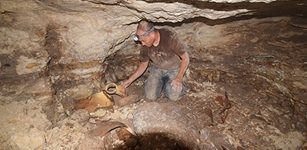 A 2000-Year-Old Jewish Settlement Near Bet Shemesh – Unearthed
Archaeology | Mar 30, 2017
A 2000-Year-Old Jewish Settlement Near Bet Shemesh – Unearthed
Archaeology | Mar 30, 2017 -
 First Fossils Of Ancient Human Relatives Sent To Space – Tribute To Science And Our Ancient History
Fossils | Sep 12, 2023
First Fossils Of Ancient Human Relatives Sent To Space – Tribute To Science And Our Ancient History
Fossils | Sep 12, 2023 -
 Radiocarbon Dating Sheds Light On Historical Events In The Ancient City Of Gezer
Archaeology | Nov 15, 2023
Radiocarbon Dating Sheds Light On Historical Events In The Ancient City Of Gezer
Archaeology | Nov 15, 2023 -
 Is Ipuwer Papyrus A Report Of An Ancient Catastrophe?
Artifacts | Aug 7, 2017
Is Ipuwer Papyrus A Report Of An Ancient Catastrophe?
Artifacts | Aug 7, 2017 -
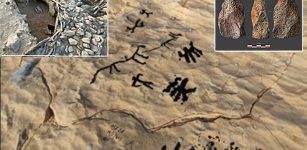 Unique Finds Discovered In Oman – Rub’al-Chali Desert Reveals Its Secrets
Archaeology | Apr 20, 2023
Unique Finds Discovered In Oman – Rub’al-Chali Desert Reveals Its Secrets
Archaeology | Apr 20, 2023 -
 How Did The Early Rapa Nui People Put Huge Hats On Giant Statues Of Easter Island?
Ancient Technology | Jun 5, 2018
How Did The Early Rapa Nui People Put Huge Hats On Giant Statues Of Easter Island?
Ancient Technology | Jun 5, 2018 -
 Ancient Manuscript In Museum Reveals Discovery Of Objects Unknown To Modern Science – Why Were The Ancient Time Capsules Hidden? – Part 3
Ancient Mysteries | Apr 14, 2021
Ancient Manuscript In Museum Reveals Discovery Of Objects Unknown To Modern Science – Why Were The Ancient Time Capsules Hidden? – Part 3
Ancient Mysteries | Apr 14, 2021 -
 Biblical Pool Of Siloam In The City of David To Be Excavated And Opened To The Public
Archaeology | Jan 2, 2023
Biblical Pool Of Siloam In The City of David To Be Excavated And Opened To The Public
Archaeology | Jan 2, 2023 -
 Freemasons Secrets – American Democracy Is Part Of An Ancient Universal Plan – Egyptian Temple And Legendary Expedition Hold The Clues – Part 2
Ancient Mysteries | Jul 13, 2018
Freemasons Secrets – American Democracy Is Part Of An Ancient Universal Plan – Egyptian Temple And Legendary Expedition Hold The Clues – Part 2
Ancient Mysteries | Jul 13, 2018 -
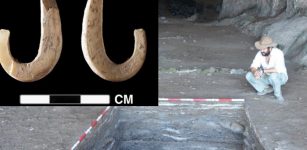 Late Pleistocene Human Colonization – What Makes Our Species Unique Compared To Other Hominins?
Archaeology | Apr 29, 2020
Late Pleistocene Human Colonization – What Makes Our Species Unique Compared To Other Hominins?
Archaeology | Apr 29, 2020 -
 Attempt To Smuggle Three Artefacts From Alexandria Port – Failed
Artifacts | Oct 28, 2020
Attempt To Smuggle Three Artefacts From Alexandria Port – Failed
Artifacts | Oct 28, 2020 -
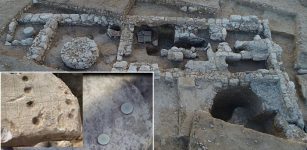 1,200-Year-Old Soap ‘Factory’ Unearthed In Beduin City Of Rahat In Israel
Archaeology | Aug 18, 2020
1,200-Year-Old Soap ‘Factory’ Unearthed In Beduin City Of Rahat In Israel
Archaeology | Aug 18, 2020 -
 Was 4,000-Year-Old Seahenge In Norfolk Built To Battle Climate Change?
Archaeology | May 31, 2024
Was 4,000-Year-Old Seahenge In Norfolk Built To Battle Climate Change?
Archaeology | May 31, 2024 -
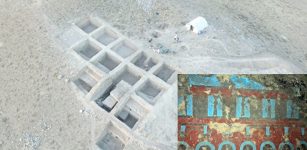 First Look At Mysterious 2,700-Year-Old Underground Frescoes Hidden Inside An Urartu Structure
Archaeology | Oct 6, 2022
First Look At Mysterious 2,700-Year-Old Underground Frescoes Hidden Inside An Urartu Structure
Archaeology | Oct 6, 2022 -
 Rare Gold Foils Found In Ancient Egyptian Tombs At Tel El-Deir In New Damietta
Archaeology | Jul 24, 2024
Rare Gold Foils Found In Ancient Egyptian Tombs At Tel El-Deir In New Damietta
Archaeology | Jul 24, 2024 -
 Thousands Of Remarkable Megaliths On The Sumba Island
Featured Stories | Aug 30, 2017
Thousands Of Remarkable Megaliths On The Sumba Island
Featured Stories | Aug 30, 2017 -
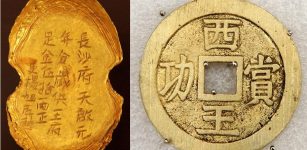 Ancient Legend Is Now Proven True: Sunken Treasure Of Gold And Silver Found
Archaeology | Mar 22, 2017
Ancient Legend Is Now Proven True: Sunken Treasure Of Gold And Silver Found
Archaeology | Mar 22, 2017

